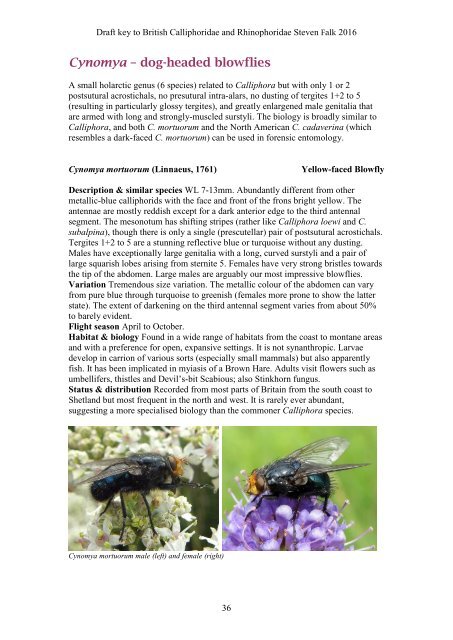BRITISH BLOWFLIES (CALLIPHORIDAE) AND WOODLOUSE FLIES (RHINOPHORIDAE)
4cmTmdCuA
4cmTmdCuA
You also want an ePaper? Increase the reach of your titles
YUMPU automatically turns print PDFs into web optimized ePapers that Google loves.
Draft key to British Calliphoridae and Rhinophoridae Steven Falk 2016<br />
Cynomya – dog-headed blowflies<br />
A small holarctic genus (6 species) related to Calliphora but with only 1 or 2<br />
postsutural acrostichals, no presutural intra-alars, no dusting of tergites 1+2 to 5<br />
(resulting in particularly glossy tergites), and greatly enlargened male genitalia that<br />
are armed with long and strongly-muscled surstyli. The biology is broadly similar to<br />
Calliphora, and both C. mortuorum and the North American C. cadaverina (which<br />
resembles a dark-faced C. mortuorum) can be used in forensic entomology.<br />
Cynomya mortuorum (Linnaeus, 1761)<br />
Yellow-faced Blowfly<br />
Description & similar species WL 7-13mm. Abundantly different from other<br />
metallic-blue calliphorids with the face and front of the frons bright yellow. The<br />
antennae are mostly reddish except for a dark anterior edge to the third antennal<br />
segment. The mesonotum has shifting stripes (rather like Calliphora loewi and C.<br />
subalpina), though there is only a single (prescutellar) pair of postsutural acrostichals.<br />
Tergites 1+2 to 5 are a stunning reflective blue or turquoise without any dusting.<br />
Males have exceptionally large genitalia with a long, curved surstyli and a pair of<br />
large squarish lobes arising from sternite 5. Females have very strong bristles towards<br />
the tip of the abdomen. Large males are arguably our most impressive blowflies.<br />
Variation Tremendous size variation. The metallic colour of the abdomen can vary<br />
from pure blue through turquoise to greenish (females more prone to show the latter<br />
state). The extent of darkening on the third antennal segment varies from about 50%<br />
to barely evident.<br />
Flight season April to October.<br />
Habitat & biology Found in a wide range of habitats from the coast to montane areas<br />
and with a preference for open, expansive settings. It is not synanthropic. Larvae<br />
develop in carrion of various sorts (especially small mammals) but also apparently<br />
fish. It has been implicated in myiasis of a Brown Hare. Adults visit flowers such as<br />
umbellifers, thistles and Devil’s-bit Scabious; also Stinkhorn fungus.<br />
Status & distribution Recorded from most parts of Britain from the south coast to<br />
Shetland but most frequent in the north and west. It is rarely ever abundant,<br />
suggesting a more specialised biology than the commoner Calliphora species.<br />
Cynomya mortuorum male (left) and female (right)<br />
36


